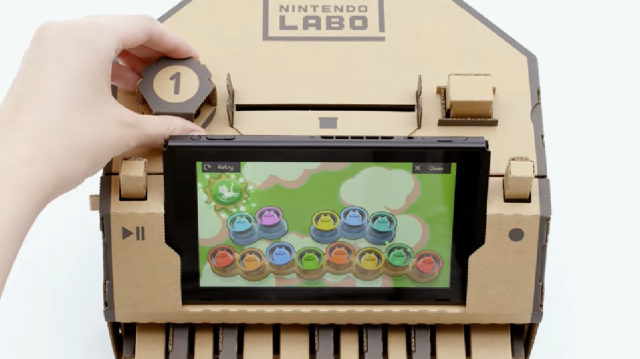
One Japanese netizen guesses that it has to do with fundamental problems in the Japanese education system.
Nintendo Labo kits are accessories to the Nintendo Switch that were released earlier this year. The sets come in cardboard pieces, which players put together and fit with the Switch’s Joycon controllers and screen to make cool tools like steering wheels and pianos that can be used with certain games. With the concept of “Make. Play. Discover”, they’re marketed for children, in the hope that kids will learn about engineering and science while building and playing with them.
https://www.youtube.com/watch?v=P3Bd3HUMkyU
Since the kits are intended to be educational, Nintendo has decided to see how the toys might fit into schools. Starting in November, in partnership with the U.S. nonprofit organization Institute of Play, the company will be giving Nintendo Switches, Labo kits, and a Nintendo Labo Teacher’s Guide to schools in the New York area and across the U.S. to see if they can be implemented into their STEAM (science, technology, engineering, art, and mathematics) programs.
We’ve already seen how some people can be pretty creative with Nintendo Labo, so it’s no surprise that Nintendo would want to see if they can be used in education. But why send them to U.S. schools, instead of schools in Nintendo’s home country of Japan? Japanese Twitter user Min Onouchi thinks that’s cause for concern, and an indication that the Japanese education system is failing.
▼ Translation below.
“We should really be thinking about why Nintendo, a Japanese company, is giving away free Labos to U.S. schools instead of Japanese ones. I think that, even if they were distributed to Japanese schools, Japanese teachers won’t know how to use them, and they’d just be wasted. If we look we could probably find organizations like Institute of Play in Japan, but because the [current educational] system would keep them from connecting with schools, teachers are too busy to use them, and all of the other problems with the Japanese school system, Nintendo probably thought they’d have a higher likelihood of success if they try it with American schools instead of Japanese ones, despite the fact that, no matter the genre, broadening kids’ horizons like this has been linked to improved development.”
The other “problems” that Onouchi mentions are clarified in a later Tweet to include “no leeway to implement new things”, and “the rigidity of the system”, in addition to overworked teachers. These are fair points to make, since it’s well known that Japanese schools are pretty inflexible, especially considering one teacher marked a student’s answer wrong for writing the number “4” incorrectly.
Onouchi had more to say, however, in two follow-up tweets that further criticize the Japanese education system:
▼ Translations below.
“I think Nintendo’s decision to start this program in America and not Japan is right. I think it’s impossible for one company to try to fix the problems with Japan’s education system. Japan’s stigma against expanding kids’ horizon is a result of our focus on accomplishment, like how only universities whose professors have won Nobel prizes will get funding for even the most basic studies.
Especially in politics and economics, people who keep achieving short-sighted accomplishments (even if they’re not really accomplishments at all) will continue to be revered and valued in this country because of our “focus on accomplishment” disease. I can’t help but think that our country’s future is steadily sinking.”
Onouchi is not the only one to believe that the Japanese education system needs revision. Nobel prize-winner Shuji Nakamura and famed educator Hirotaka Otatake might be inclined to agree. Both revered men have commented that the Japanese education system, with its short-sighted goals of passing exams and getting jobs in major companies, is not flexible enough or effective enough to prepare Japanese youth for participation in a dynamic, global world.
And yet, Onouchi’s post sparked a debate among the less-illustrious of Japan’s population, as many Japanese netizens thought there might be other reasons behind the decision, or why the Labos couldn’t be implemented into Japanese schools:
“I think there are teachers who would know how to use Nintendo Labo in their classrooms, but I think school management wouldn’t be flexible enough to allow it.”
“It’s probably because there are too many people in higher positions who would say things like ‘Famicoms don’t belong in schools!'”
“I think an important point is that they want to spread it to schools across the U.S. That’s because they have the possibility of a much wider data analysis.”
“It might simply be because the American nonprofit organization is contributing money to the project. There are probably other reasons too.”
“That might be true, but there are also probably rules against specific companies’ products being used in education, or something like that.”
“Instead of the organizations not being able to connect with the schools, wouldn’t it rather be that they just don’t have the budget for it?”
As many people pointed out, it’s possible that the decision had nothing at all do with the Japanese education system. Perhaps it was simply due to conditions in the Nintendo Labo’s success in the U.S. market, and the U.S. division proposed this project because they’re hoping to sell more by exposing more kids to the product. Or, perhaps it was not even Nintendo’s idea at all, but rather a proposal from Institute of Play. Who knows?
Still, it is rather hard to see any kind of technological fun being implemented in Japanese schools, since classrooms are still notoriously low-tech. Nevertheless, it’s not all bad, as some teachers are finding ways to reward their students for independent learning and curiosity, in spite of a system that still hammers down the nails that stick out.
Source: Techcrunch, Twitter/@kaerumin via Hachima Kiko
Top image: YouTube/Nintendo